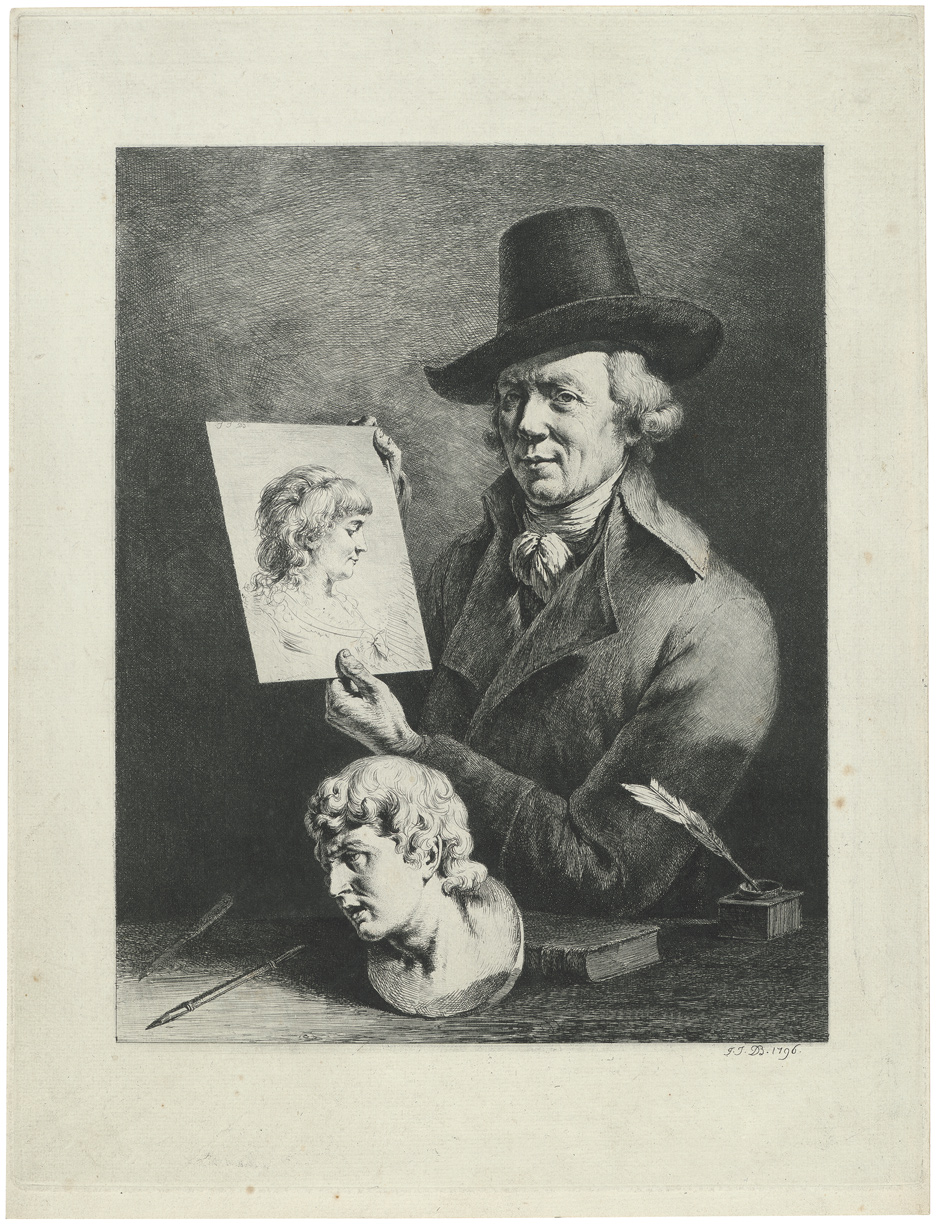Loading the page ...
Jean Jacques de Boissieu
(1736–1810, Lyon)
Self-portrait. Etching, drypoint and roulette on greyish-blue paper. 29.5 x 37.5 cm. 1796. Boissieu-Perez 102 IV (of VI).
This sensitive self-portrait has long been regarded as one of de Boissieu’s outstanding prints and rightly so. It radiates self-confidence and the experience that comes with maturity. The artist has portrayed himself in half length with the upper part of his body and accurately rendered face turned towards the viewer. In his hands the elegantly clad master holds a copper plate with a portrait of his wife. Spread out on a table top are various attributes alluding to de Boissieu’s artistic activities and his classical education. Prominently positioned and highlighted by a bright beam of light is the plaster head of one of the figures from the Laocoön Group.
The portrait is distinguished not just by its subtle psychological characterisation, but also by the refinement of the technical execution. De Boissieu was an extraordinarily skilful and versatile etcher who fully exploited the expressive potential of the medium. This explains the great influence he had on later French etchers such as Charles Meryon, Félix Bracquemond and other exponents of the art, which experienced a revival in the 1860s. In the first state the self-portrait exists solely as an etching. In the two following states the artist made fine corrections with a drypoint and roulette, thus effecting delicate tonal gradations and a subtle play of light. This high degree of graphical finesse constitutes the real hallmark of de Boissieu’s art. The present fourth state is the rarest version of this remarkable self-portrait. It is printed on greyish-blue paper, which was typical of print production in Lyon around 1800. De Boissieu used this paper for his best impressions. His wife died at the time this portrait was taken. In the fifth state de Boissieu replaced her portrait with a landscape.
Jean-Jacques de Boissieu, born into a noble family from the Auvergne, lived and worked for most of his life in his native Lyon. In 1771 the artist was appointed Treasurer of France, a position which subsequently gave him financial independence. De Boissieu was a self-willed person who devoted himself consistently to his art and lived in relative seclusion. After studying under the history painter, Charles Frontier, de Boissieu spent the years from 1762 to 1764 in Paris, where he became friends with such leading artists of his time as Joseph Vernet, Johan Georg Wille and Jean-Baptiste Greuze and maintained contacts with patrons and collectors like Pierre-Jean Mariette and Claude-Henri Watelet. De Boissieu’s work never seems to have been influenced by the Rococo spirit of the age any more than it was by the later vogue for Neoclassicism. Together with his patron, Francois Alexandre Duc de la Rochefoucauld, he went on a Grand Tour of Italy in 1764/5, returning with an abundance of landscape studies that would serve him as a source of inspiration for the rest of his days.
The political upheavals of the French Revolution marked a dramatic turning point in de Boissieu’s life, depriving him of his office and his fortune. His artistic career did not suffer, however. He subsequently worked almost exclusively as a draughtsman and etcher, personally overseeing the sale of his artworks. In this respect he proved extremely successful, for his prints were in great demand among collectors and enthusiasts not only in France, but also in Germany. The large number of complete editions of his printed works bears testimony to his great popularity. A superb, contrasting and nuanced impression with thread margins around the platemark. Minimal foxing, minor ageing, otherwise in mint condition.
